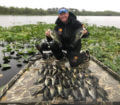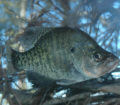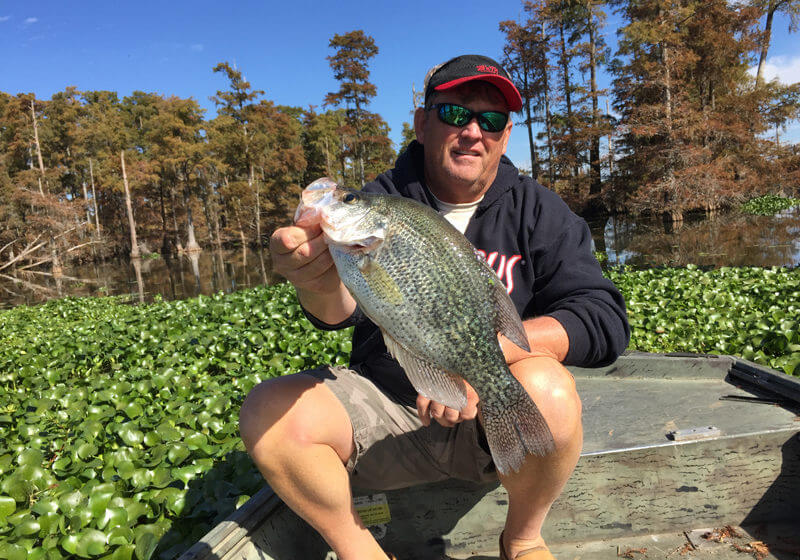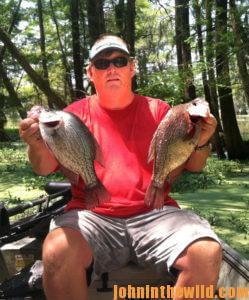 Editor’s Note: Whitey Outlaw from St. Matthews, South Carolina, has been fishing crappie tournaments for the last 40 years. He’s a third-generation crappie fisherman and consistently finishes in the top 15 in most of the tournaments he enters. Whitey’s home lake is Santee Cooper in South Carolina that was impounded from the Congaree River. Like most river systems, whether they’re dammed up or not, the Congaree was supported by a wide variety of creeks – often well away from the main river. Many of these creeks went through cypress and tupelo hardwood forests. So, when the river started backing up, these creeks were flooded and created what Outlaw calls, “The Swamp.” Many of these creeks became oxbow lakes that were cut off from the main river channel when the lake was impounded. The swamps that Outlaw fishes include Broadwater, McGirth’s Lake, Otter Flat and all the swamps attached to the main lake. However, most all rivers anywhere – whether they’re a part of a lake or a free-flowing stream – have creeks coming into them. Many of these creeks will have grass in them and often standing timber, just like they do at Santee Cooper in South Carolina.
Editor’s Note: Whitey Outlaw from St. Matthews, South Carolina, has been fishing crappie tournaments for the last 40 years. He’s a third-generation crappie fisherman and consistently finishes in the top 15 in most of the tournaments he enters. Whitey’s home lake is Santee Cooper in South Carolina that was impounded from the Congaree River. Like most river systems, whether they’re dammed up or not, the Congaree was supported by a wide variety of creeks – often well away from the main river. Many of these creeks went through cypress and tupelo hardwood forests. So, when the river started backing up, these creeks were flooded and created what Outlaw calls, “The Swamp.” Many of these creeks became oxbow lakes that were cut off from the main river channel when the lake was impounded. The swamps that Outlaw fishes include Broadwater, McGirth’s Lake, Otter Flat and all the swamps attached to the main lake. However, most all rivers anywhere – whether they’re a part of a lake or a free-flowing stream – have creeks coming into them. Many of these creeks will have grass in them and often standing timber, just like they do at Santee Cooper in South Carolina.
“Most of the time I’ll be fishing 10-pound-test Slime Line (https://catchthefever.com/),” explains Whitey Outlaw. “A lot of people ask me, ‘Why aren’t you fishing with 4-6-pound test line like most crappie fishermen use?’ There are several reasons why I fish this line. The grass is abrasive, it can weaken small-diameter line to the point that your line will break, and you’ll lose more fish than I want to lose. To land a crappie, I use one hard pull on my B’n’M pole (https://www.bnmpoles.com/). I want to snatch that crappie out of the grass before it can run around in the grass and my line becomes weakened from being hung-up in that grass. Now the reason I use Slime Line Super Stretch, which is a new cypress-green color of line that just came to the marketplace in about 2017-2018, is it’s the only crappie-fishing line that has about 30% stretch built into the lines. Most people don’t like to have stretch in their line. That’s the reason they use fluorocarbon and braid, unless they’re fishing a crankbait. Then they’ll tolerate a little stretch in the line.
“If you’re wondering why we deliberately buy a line with stretch in it, we’ve worked with this company to try and help develop a line that’s more suitable for crappie fishing than most of the line you can buy on the market, which is primarily designed for bass fishing. We fish tight lines with no bobbers. The line goes straight from the tip of the pole to the eye of the hook. When a crappie takes a jig, the fish usually will run to the left or the right, or straight away from the boat. And often, they’ll tear off the hooks. That’s why crappie are called papermouths. The membrane that creates the crappie’s mouth is very thin, much like newspaper or tissue paper. Bass fishermen and saltwater fishermen are trying to catch fish that have bony-type mouths, and they must set their hooks hard and fast to drive the points of the hooks and the barbs through or past those bony mouths.
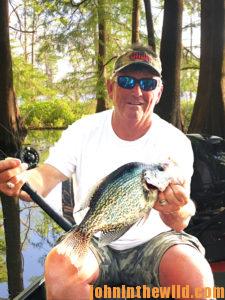 “We wanted a line that would flex more (stretch more when the crappie takes the bait), and this new Slime Line will stretch 33% when the crappie takes the bait. Then once the crappie’s taken off the hook, the line returns to its original size and weight. The Slime Line is much like a bungee cord in that it stretches when it’s pulled, and it goes back to its original size and shape when it’s not pulled. That tight line results in a softer hookset and acts like a shock absorber when the crappie starts to run and pull on the line.
“We wanted a line that would flex more (stretch more when the crappie takes the bait), and this new Slime Line will stretch 33% when the crappie takes the bait. Then once the crappie’s taken off the hook, the line returns to its original size and weight. The Slime Line is much like a bungee cord in that it stretches when it’s pulled, and it goes back to its original size and shape when it’s not pulled. That tight line results in a softer hookset and acts like a shock absorber when the crappie starts to run and pull on the line.
“I like using 10-pound-test line, because I catch many other fish that aren’t crappie when I’m digging holes and fishing through the grass. I’ll usually catch a good number of bass, a lot of jackfish (chain pickerel) and quite a few catfish. So, I need a heavy-enough line to land those fish if we happen to catch one, but most of the time using this technique, we’ll just catch crappie.
“The B’n’M Pole Company produces a pole called the Santee Elite Whitey Outlaw Series. I helped design this pole to have the features I needed in a pole to fish through grass for crappie. Unlike other crappie poles, instead of the lines running through the guides on tops of the poles, the lines run through the centers of the poles. So, there are no guides on the pole to hang-up in the grass when you’re trying to retrieve your jigs. Many times, your jig will get hung in the grass or in some other structure under the water. With most poles, to retrieve that jig, you put the pole in the water and slide through the jig. Once the pole reaches the head of the jig, you can use the tip of the pole to push the jig off the structure or to pull it through the grass. However, if your pole has guides on top of the pole for lines to go through, those guides often will get hung in the grass or in the underwater structure that you can’t see. Sometimes your guides even may break or bend when you retrieve your jig. But by having the line running through the pole and using no guides, you won’t have that problem.
“I like the 10-foot Santee Elite poles best because that’s usually the maximum distance that I’ll have the pole from the boat when I dig holes in the grass. I can pull my jig all the way to the end of the pole if I want to and let it fall vertically into the hole, especially if the wind’s blowing. Or, on calm days I can swing my jig out over the hole and let it drop into the hole. Another reason I like this 10-foot pole is because it has a lot of backbone in it (strength and lifting power). I can pull a 1-3/4-pound crappie from the time I hook the fish up through the hole and straight into the boat, without having to use a dip net. This is a real advantage when you’re fishing in grass.
“In the spring and in mid-winter, the crappie I catch in the grass usually will weigh from 1-1/2 – 2 pounds or more. So, to jack that crappie out of the grass and into the boat, I need a pole that has the power to lift that fish from where it gets hooked and pull it through the air until the crappie lands in my boat. That’s why I like this pole better than any other pole for fishing for crappie. Regardless of what anyone may tell you, a 2-pound crappie is a really-big fish, and you need a strong pole to get it out of the water and into the boat quickly. My biggest crappie that I’ve ever 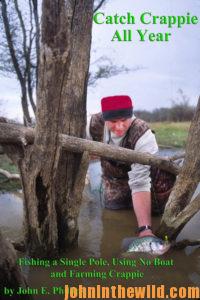 caught weighed 3.2 pounds.”
caught weighed 3.2 pounds.”
To learn more about crappie fishing, check out John E. Phillips’ book, “Catch Crappie All Year: Fishing a Single Pole, Using No Boat and Farming Crappie,” available in Kindle, print and Audible versions at https://amzn.to/31Ybf0W.
Tomorrow: How Many Crappie Does Whitey Outlaw Catch Through the Holes He Digs?

